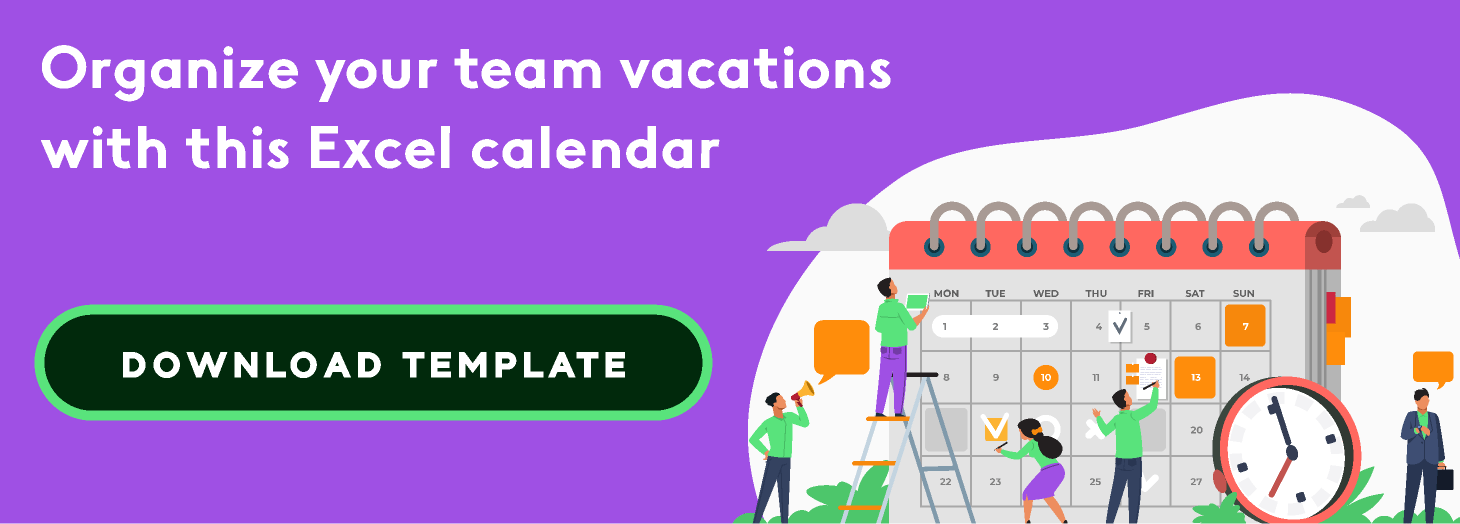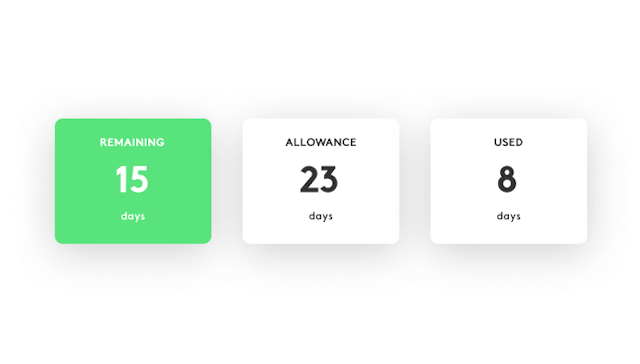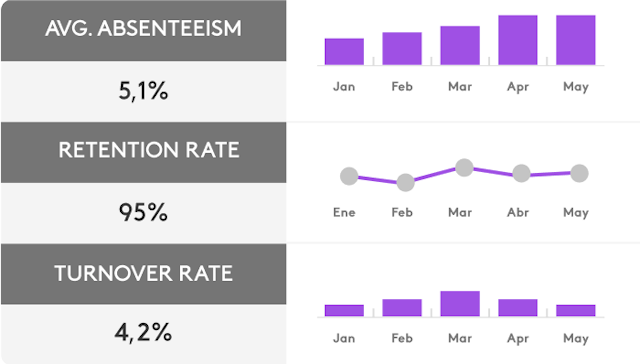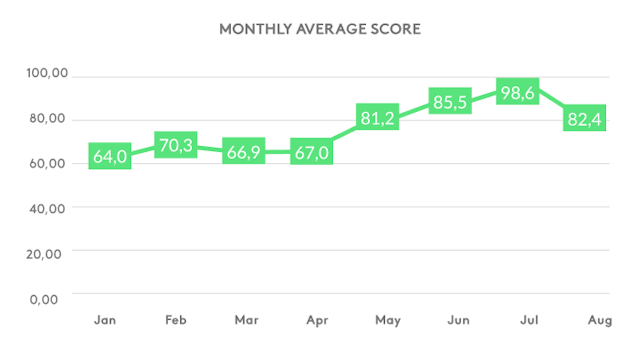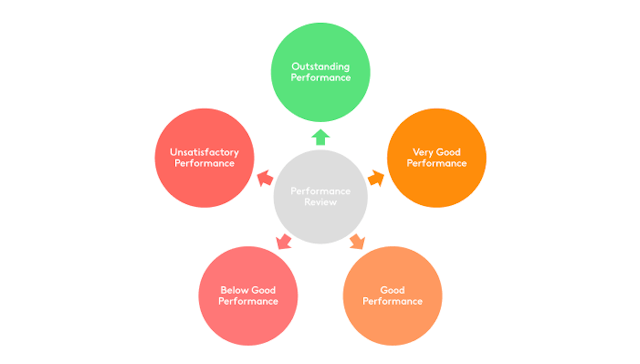Table of Contents
Calculator to find out your annual leave entitlement
Our simple calculator will help you find out how many days of annual leave you are entitled to, for every day worked. Simply fill in the fields to get your result.
REMAINING
days
ALLOWANCE
days
USED
days
How many business days per week does your company operate?
days
What is your annual leave allowance in days?
days
How many days a week do you work?
days
Have you already taken some of your annual leave allowance?
Pro-rata calculations
How to manage your employees annual leave?
Calculating annual leave for your workforce often raises doubts; this is especially true when regulations change or when unusual circumstances arise. For example:

Is an employee entitled to annual leave after being on sick leave?

How many days off is a part-time worker entitled to?

Can a company unilaterally change the holiday schedule?
We answer these, and many other questions below, to make the task ofcalculating annual leavefor your team faster and easier.
What does UK employment law say about annual leave?
The Working Time Regulations governs the regulations for annual leave, together with the collective agreement for each sector, and every employee’s work contract. These texts establish the limits and conditions of any professional relationship.
ANNUAL LEAVE UK EMPLOYMENT LAW HIGHLIGHTS
Holidays are both a right and an obligation for employees. In other words, they must be taken, no matter what.
Every direct employee has the right to a minimum of 28 working days of paid holiday per year, although the collective agreement or the company can increase this number (but never reduce it).
Annual leave cannot be exchanged for cash.
Holidays are not cumulative, and cannot be carried over to the following year.
Annual leave must be agreed in advance between the company and the employee.
Employees cannot be penalised and given less than the minimum annual leave.
Employees must take at least two weeks of uninterrupted annual leave.
They are entitled to receive 100% pay during periods of annual leave.
This blog article, written by Landau Law - specialist employment law solicitors - summarises the most important points relating to annual leave regulations in the UK.
A collective agreement, on the other hand, looks into detailed aspects that are not covered by the Working Time Regulations, such as, for example, the days an employee can take in the event of a serious illness in the family, among others. It is an agreement between the employer (or employer’s association) and the trade union. This agreement is only legally binding where it is expressly incorporated into the employee’s contract, in as far as elements that are suitable for incorporation, that are related to pay, hours, disciplinary procedures and sick pay. Essentially, the conditions in the employee’s contract will prevail and these should be read carefully at the start of any working relationship.
All employees in the UK are entitled to the statutory 28 working days’ annual leave, although there are other circumstances where the employer must allow an employee time off. The Working Time Regulations include circumstances such as jury service, emergency situations relating to family dependants or time off for public duty (although employers are not obliged to pay the employee for the latter, if they choose not to). Employees also have the right to paid leave are maternity or paternity leave, for example.
Ultimately, annual leave is obligatory and fundamental for employees. Holidays enable them to rest and return to the activity with more energy. In fact, this article explains how employee performance improves after taking annual leave. The results are beneficial for both sides.
Learning resources on the legalities of absence from work
Do you have specific queries about workforce holidays and absences? Go directly to the source to find the answers. We’ve gathered links to some official and reputable websites where you can find the information:
How is annual leave entitlement calculated?
UK employees have the right to a minimum of 28 working days’ annual leave, so this should be used as the basis for calculating annual leave entitlement. In most cases, an employee taking one week of annual leave is only taking five working days. Working days should not be confused with calendar days. Most employees are required to work five days a week.
Employees who work from Monday to Friday would therefore usually have seven days’ rest, as Saturday and Sunday are not included in their annual leave total.
Annual leave and bank holidays

There is an average of eight bank holidays in the UK every year, with some variations in Scotland and Northern Ireland. These include Christmas Day, New Year’s Day and Easter Sunday among others. Employers are allowed to include these eight bank holidays into the employee’s entitlement of 28 days of paid annual leave.
Some employers may include28 days of annual leaveplus any relevant bank holidays. This depends on the contract between employer and employee. If your place of work is closed on bank holidays, then employees must take the day off.
Nevertheless, employees do not have a legal entitlement to take days off on bank holidays. In some industries, businesses do not close on bank holidays and some workers may be required to work. They will of course be paid for working on bank holidays, just like any other day. Some industries may offer extra pay to employees who work on bank holidays, but this is not a legal entitlement.
How to calculate annual leave entitlement?
All employees in the UK are entitled to 28 working days’ annual leave (plus bank holidays if specified in the contract). These days must be taken from January to December. However, should an employee join a company halfway during the year, HR departments have to calculate how many days of annual leave they will be entitled to for the rest of that year.
Calculating annual leave entitlement for UK employees is very simple. Just divide the number of days of annual leave specified in the contract or collective agreement, by the 12 months in the year. The result tells you how many days the employee would be entitled to per month. Then, multiply this number by the number of months left until the end of the year.
Therefore, with a total of 28 working days a year, an employee has the right to 2.33 days annual leave for every month worked.
If a new employee joins the company on 1 July, then they would have to take 14 days’ holiday before the end of the year. How do we arrive at this total? By multiplying the monthly annual leave entitlement by the number of months left until the end of the year, six in this case). If our calculations result in an uneven number, then we simply round up (but never down) to the next whole number.
See the exact calculations below:
- (22 / 12) * 6 = 11 days annual leave.
An Excel annual leave spreadsheet can prove very useful at times like this, as it enables you to perform these calculations almost automatically, avoiding errors and oversights.
Calculating annual leave entitlement for part-time employees
A part-time employee in the UK is entitled to the same annual entitlement as full-time employees, on a pro rata basis. If a full-time employee is entitled to 28 days per year, then someone who works three days a week will be entitled to two-thirds of that.
How to calculate annual leave for part-time workers.
What formula can we use to calculate the annual leave entitlement of a part-time worker?
For example: A part-time receptionist works three days a week. To calculate their annual leave entitlement, we must multiply the number of days worked per week by 5.6 (the number of weeks’ annual leave entitlement in the UK).
Therefore: 5.6 x 3 = 16.8 days per year.
The receptionist will be entitled to 16.8 days of paid annual leave per year.
Who decides when annual leave will be taken: employer or employee?
Exactly when annual is to be taken will depend on the company and industry concerned. An employer can decide when its employees take their annual leave, such as when an entire factory closes down over Christmas, for example. In other sectors, the employee can request the dates they prefer, and it will be subject to the employer’s approval (who can, if they wish, refuse the specific dates requested).
Whatever the situation, both parties are obliged to give at least the same notice as the amount of leave requested. In other words, an employee who wants to request one week off should make that request at least one week in advance. An employer who decides to give employees two weeks off must notify them at least two weeks beforehand.
Most companies have established norms and procedures for annual leave, and all employees should be made aware of this to avoid conflicts and misunderstandings. For example:
- Priority: a company can use its discretion when giving priority for annual leave requests, such as in the case of families with children, or on a “first come, first served” basis.
- The number of workers that can take holidays at once to ensure that the activity will not be affected.
- A holiday rota can be useful in some areas to ensure that there is always a specialist on duty.
Establishing a work schedule is often a much simpler way to satisfy everyone involved.
How much advance notice of annual leave should an employer give?
Employees should be made aware of the holiday planner in advance, by at least two days for every day of annual leave to be taken, although the collective agreement can set a longer timescale. So, if an employer advises workers that they have to take two weeks off, then they must give at least four weeks’ notice.
Sending written notification of this avoids any issues in the future, via a digital channel if possible, as the system will hold confirmation of the notification. When an employee requests days off, you can automate these notifications through Kenjo annual leave management software. They will be registered in the calendar and the information will be available to the rest of the team.
Can the company change the holiday calendar?
Generally speaking, the company cannot change the holiday calendar once it has been approved. Nevertheless, should certain force majeure circumstances arise (such as production or business issues) and the company duly justifies them, they can make the changes they require.
The employee can modify this in the event of unforeseen circumstances, as long as this is not detrimental to the company and both sides reach a mutual agreement.
It’s also important to mention that, should a company ask an employee to work during their holiday period, the employee is not obliged to do so. Exceptions should be made in the event of an emergency, however, as a judge may determine that the request is justified.
Can you pay an employee in lieu of annual leave?
Definitely not. The Working Time Regulations state that an employee has a legal right to 28 working days annual leave, and that these cannot be exchanged for cash. If the employment contract allows more than the statutory annual leave, an employer may pay an employee for unused holidays that are above the statutory limit.
However, there are two kinds of statutory leave in the UK: the first type is determined by EU law, which allows four weeks’ holiday per year. This cannot be carried over and must be taken.
The second type originates from UK law, which allows an extra eight days (or 1.6 weeks). This can be carried over to the following year if the employer and employee reach a mutual agreement. An employer may also include further days of annual leave in an employee’s contract, in which case these too could be carried over if mutually agreed.
There are two known exceptions where a company will have to pay employees in lieu of untaken annual leave. These are:
1. Termination of contract
When a working relationship comes to an end, for whatever reason, and before the full holiday entitlement has been taken, an employee must receive payment in lieu of annual leave. In other words, the company must calculate the proportional financial compensation for any untaken holidays, based on their salary and on the number of months worked during the year up to the termination date. This amount will be included in the employee’s final payment.
2. Temporary agency workers who have exceeded the 12-week qualifying period
Temporary agency workers are entitled to the same holiday allowance as directly recruited employees, once they have completed 12 weeks in the same job. This means that, on leaving the company, they must be compensated accordingly for any untaken holiday.
How to calculate payments for untaken annual leave? The most common way to calculate how many days of untaken annual leave are to be paid, is by using the simple formula: (A x B) - C.
A = the total holiday entitlement for the year (5.6 weeks).
B = the proportion of the holiday year that has passed before the termination date.
C = the amount of holiday the employee has already taken.
To reach the financial payment corresponding to untaken annual leave, you then need to work out how much the employee earns per week or day. Simply divide the annual salary by 52 - to determine an employee’s weekly salary - then divide that again by 5 to arrive at the daily rate. This figure is then multiplied by the number of untaken holiday days to give you the amount to be paid in lieu.
Download free resources for your HR department
Can untaken annual leave be carried over to the following year?
Annual leave cannot be accumulated and therefore, employees must take their minimum statutory entitlement of 28 days every year, as stated in the Working Time Regulations. They will otherwise be lost.
Having said that, collective agreement or company management can come to an arrangement where employees can carry over untaken leave, for example, and use it during the first few months of the following year.
Holiday entitlement after a period of sick leave
Despite the general rule that holidays not used during the year they are generated will be lost, there is one exception. If an employee is on sick leave and is unable to take their holidays, they can carry them over and use them as long as they do so within 18 months from the month in which they were generated.
For example: an employee has a serious illness which stops them from taking their 28 days annual leave in 2020. They begin their sick leave in July and return to work one year later. They will have until June 2021 to take these holidays.
When employees are on maternity or paternity leave, parents have the right to take their holidays after this leave ends, therefore being able to prolong the period they spend with their new child.
What if an employee falls sick during their holiday? As long as the employee reports their sickness to their employer, they can either receive sick pay for the time they were sick or keep the time to use as a future holiday.
Can an employee work in another company during their holidays?
There are no legal restrictions that prevent an employee from working elsewhere during their annual leave if they wish to do so. This will, however, depend on whether their main employee has a policy on secondary employment.
The company may allow employees to have a second job, including work during annual leave, but may also require that the employee requests authorisation first. This will also protect the employer in other situations of secondary employment which may affect the employee’s performance (in the case of moonlighting) or when their secondary employment may be with a competitor.
It’s important to remember that a company may include an exclusivity clause into a contract to prevent an employee from working in more than one company at a time. The British Government banned the use of exclusivity clauses, however, in the case of zero-hour contracts, under section 27A of the Employment Rights Act in May 2015.
Can an employee’s contract be terminated when they are on annual leave?
Yes, it is possible to fire an employee while on holiday. Notice must be sent in writing, but the notice period can only begin when the employee has had a reasonable opportunity to read it (possibly only on their return from holiday). Also, the employer must have a good reason.
- For example, the employer can make an employee redundant as long as there is reasonable justification to do so (the business is failing, or the employee’s skills are no longer needed).
- However, this does need to be discussed in person before any written redundancy notice can be issued, So the employee must have been made personally aware of the possibility before leaving for their holiday.
What is the best way to track a company’s annual leave?
The simplest and most efficient way to track employees’ annual leave is to digitise the entire process and get your team involved. The time has come to say goodbye to the traditional Excel spreadsheet and countless emails and give way to new technologies that automate and make the HR department’s job easier.
Automate your processes with annual leave management software and give employees the opportunity to request days off through a single channel. You can create a personalised approval policy in a way that you - the manager - will receive a notification to approve the request. Similarly, you can check which members of the team will be working during these dates to ensure there will be enough cover.
While we do recommend you move from Excel towards digitisation, we offer you this Excel spreadsheet to help you organise your company’s annual leave. This will enable you to start working more efficiently before taking the next step towards management software.
If, on the other hand, you prefer to fully optimise the work of your department, then Kenjo is the best option. Our tool offers a specific module for annual leave and absence management that will enable you to digitise this work from the beginning and save up to 40% of the time spent on administrative tasks.
Track annual leave and absences with Excel
Until very recently, using an Excel annual leave spreadsheet was the most commonly-used method. All your employees’ holidays, sick leave, maternity or paternity leave, etc. can be compiled in a simple spreadsheet.
The human resources manager gathers this information via email notifications from employees, and then enters it into the Excel spreadsheet. This is an entirely manual process. If the manager is an advanced Excel user, it is sometimes possible to create formulas that automatically calculates the remaining holiday days to be taken.
Use software to automate absence management
Annual leave and absence management software digitalises and simplifies the work of a human resources department and offers you benefits that Excel couldn’t possibly compete with.

Team absence calendar
See who will be working at a glance (particularly important for peak holiday periods) to ensure that your activity is not affected. The data is also updated in real time.

Visibility of absence history
You are able to effortlessly visualise each employee’s absence history using colour coding, so that you can easily identify the reasons for their absences.

Automate approval
Reduce the number of emails in your inbox with digitised holiday approval processes. You can create approval policies so that managers, for example, can approve the team’s annual leave requests before they are sent to you.

Alerts and notifications
The application will advise you when an employee has exceeded their holiday allowance or when they have been absent from work for several days. The software works for you and allows you to spend more time on other important tasks.

Automatic reports per employee, team or company
An absence management software gathers all the information within it and automatically creates valuable reports for the human resources department. You can also filter these by employee, teams or even for the entire company, and discover everything you need to know to make better decisions. For example: months of the year with the least absences, the employee who has been absent the most, etc.

Digitise your Human Resource department
In order to digitise the HR area your company needs to encourage your employees to use a digital ecosystem to streamline their attendance, request their holidays or deal with their legal and financial admin.
Kenjo, your annual leave and absence manager
Kenjo is an annual leave and absence management software designed to digitise, automate and optimise this task. You will be able to:

Make the annual leave and absence approval process easier.

Create personalised approval policies.

See overlapping requests at a glance.

Create personalised holiday policies.

Synchronise absences and leave with the calendar.

Give employees and managers access so that they can consult their team holiday planner.

Create reports.

Receive notifications.
Take advantage of our free 14-day software trial and discover everything it can do for you and your team. You’ll be amazed at the difference it makes!
